Over the last couple weeks, I’ve been trying to figure out how to describe the joy, contentment, and pride I feel when I walk around our family prairie. The old saying about photographs being worth 1000 words applies in a way, I guess, so I’m including lots of photos (taken within the last two weeks) in this post – but they’re insufficient too.
Long-time readers may remember the history of my family prairie, which was largely farmed before being re-seeded to grass in 1962 by my grandpa. There were small and scattered unplowed prairie fragments on the steep and/or low-lying portions of the site, but the vast majority of today’s 100 acre prairie was once crop land. During the last 10-15 years, we’ve been working to increase the plant diversity of the site through overseeding and grazing regimes that include intensive grazing periods followed by long periods of rest. Over time, that grazing system has evolved into what I now refer to as open-gate rotational grazing.

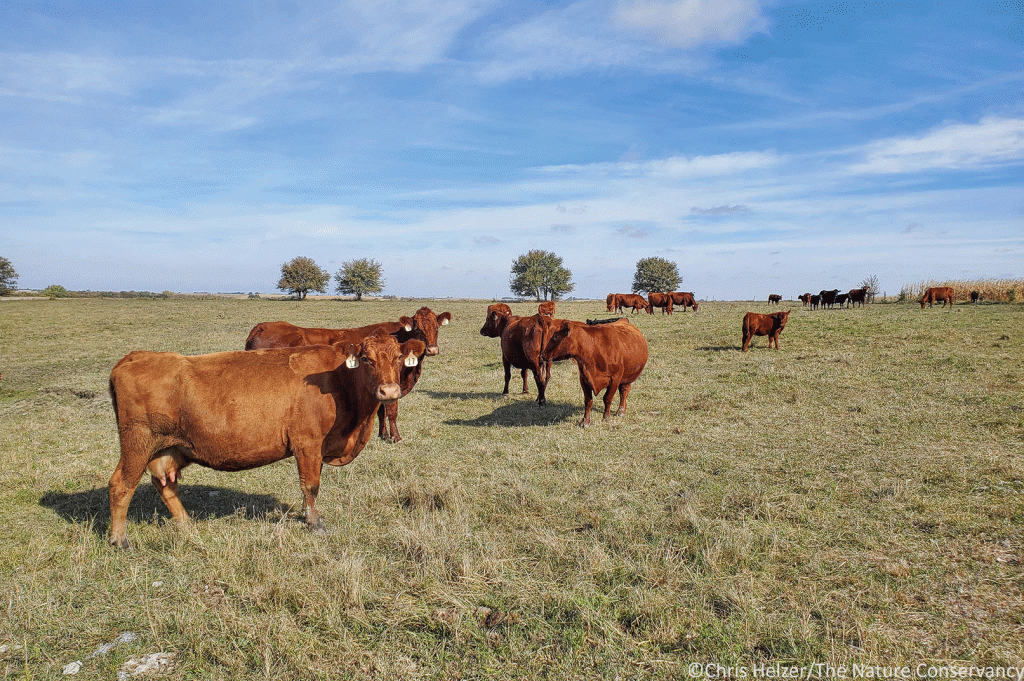
I’m really at a loss for words to describe what I’ve felt watching the prairie become more diverse and beautiful over time. I know many of you have worked on similar long-term projects and are nodding your head right now. There are some parallels with watching a garden grow and produce through time, restoring an old house to its former glory, and even (kind of) watching kids grow up and become independent and capable adults. As I walk around the prairie now, I revel in the changes I’ve helped create, but also in the extraordinary complexity of interactions I now get to observe across every square foot of the land. The prairie has a life of its own, far beyond what was created by Grandpa’s grass planting and the wildflower seeds we’ve tossed out since then.


I’m reminded of Wayne Copp’s three components of a healthy prairie, which I wrote about back in 2014: Color, Movement, and Noise. Those three attributes are ostentatiously displayed across the site right these days. The color comes from wildflowers – both long-lived and short, as well as from monarchs, regal fritillaries, and a bounty of other butterflies, bees, and invertebrates. Noises are produced by birds like upland sandpipers, grasshopper sparrows, northern bobwhite, and many more, along with the more musical invertebrates, such as katydids, grasshoppers, and crickets.
Movement comes in many forms. The slightest wind causes the flowers and grasses to dance. Birds and insects fly, hop, and crawl over and through those plants. Pocket gophers, ground squirrels, and countless invertebrates and move through the soil, with scant but present evidence of that movement. Badgers are more obvious in their excavation, and leave new mounds of soil for me to find each time I visit – and create habitat for other animals and plants to colonize.
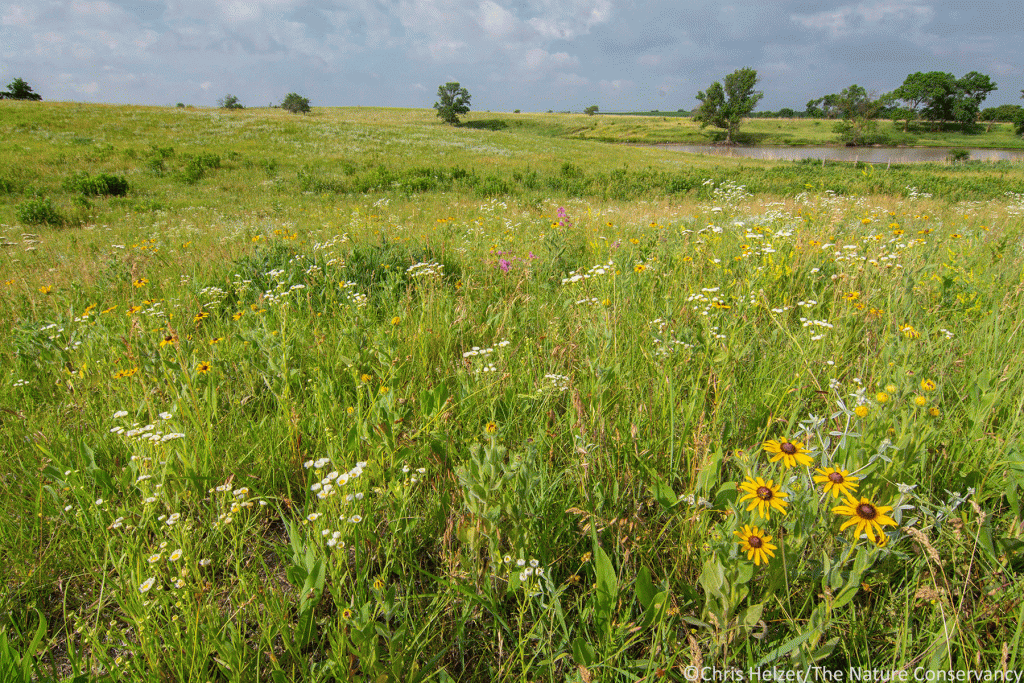
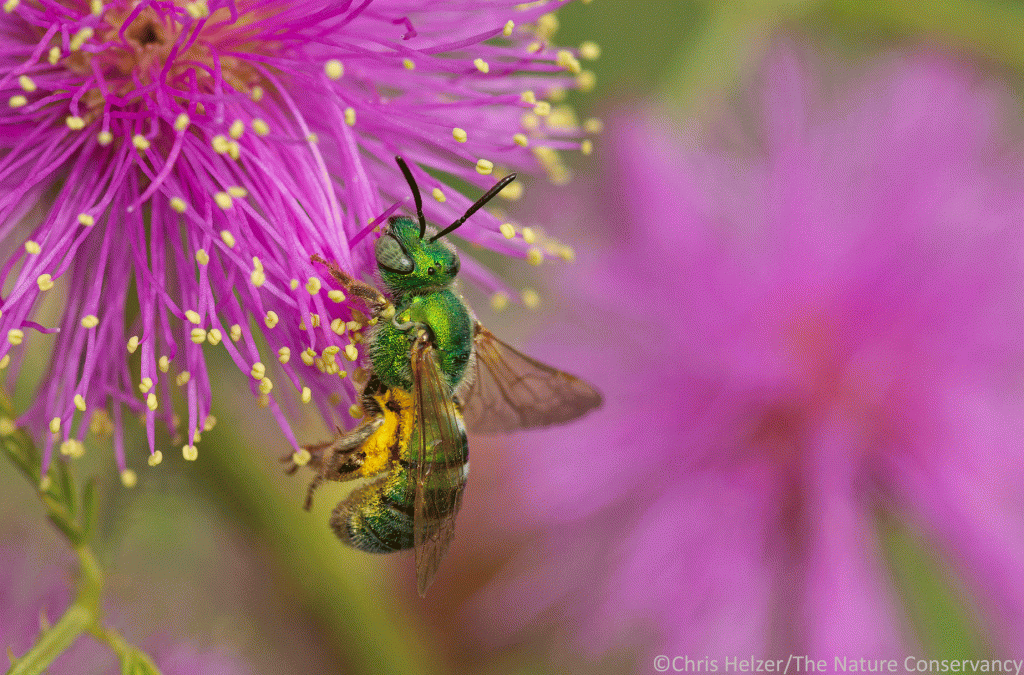
One of my favorite examples of movement has been the continuing colonization taking place by various plant species. Some are spreading outward from the small and formerly isolated fragments of remnant, unplowed prairie. Those include lead plant (Amorpha canescens), blue-eyed grass (Sisyrinchium campestre), pussytoes (Antennaria neglecta), ground plum (Astragalus crassicarpus), prairie violet (Viola pedatifida), and purple prairie clover (Dalea purpurea), among others. Each year, I find new individuals and patches of those plants further afield from where they’d been confined to tiny islands surrounded by crop land.

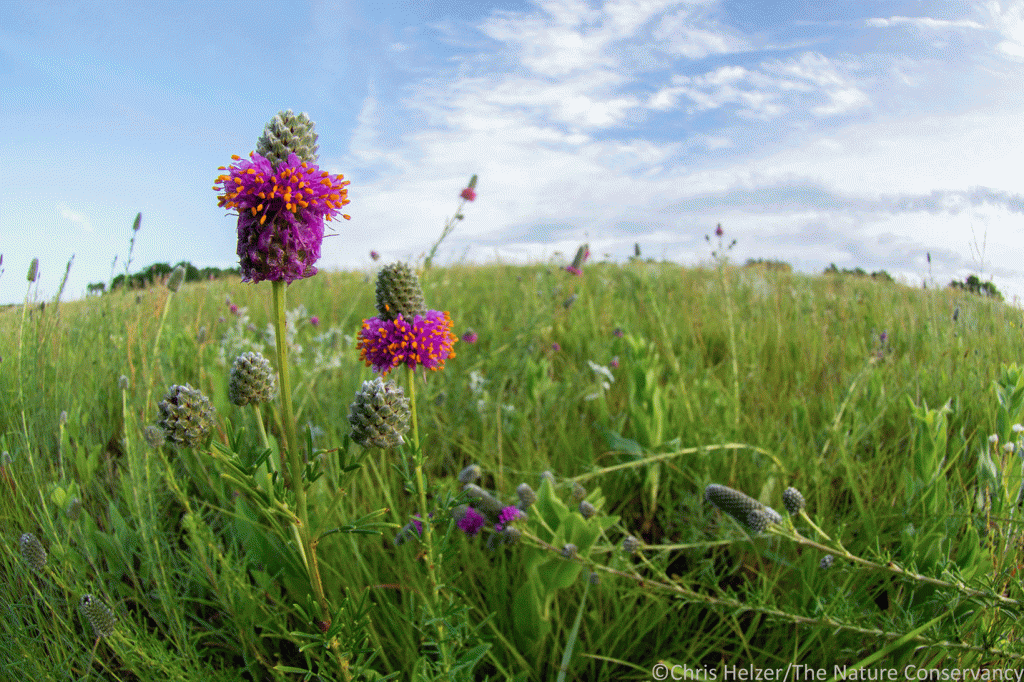
In addition, we’ve done a lot of seed harvest from other prairies and have tossed those seeds around our prairie – usually in places where cattle have recently grazed most intensively. Not everything we’ve harvested has so far established, but there’s a long list of species that have, and many of those are now spreading on their own from those initial colonizations. Species that have done particularly well include stiff sunflower (Helianthus pauciflorus), rosinweed (Silphium integrifolium), yarrow (Achillea millefolium), Canada milkvetch (Astragalus canadensis), false sunflower (Heliopsis helianthoides), black-eyed Susan (Rudbeckia hirta), wild bergamot (Monarda fistulosa), shell-leaf penstemon (Penstemon grandiflorus), and pitcher sage (Salvia azurea).
Some of today’s wildflower diversity probably arrived on its own, either as hitchhikers with the grass seed back in 1962, or through the wind or other means since then. Those include perennials like dotted gayfeather (Liatris punctata), stiff goldenrod (Solidago rigida), common, green, antelope horn, and whorled milkweeds (Asclepias sp), and cudweed sagewort (Artemisia ludoviciana), but also many shorter-lived ‘weedy’ species like daisy fleabane (Erigeron strigosus), curly-cup gumweed (Grindelia squarrosa), dandelions (Taraxacum officinale), and others.
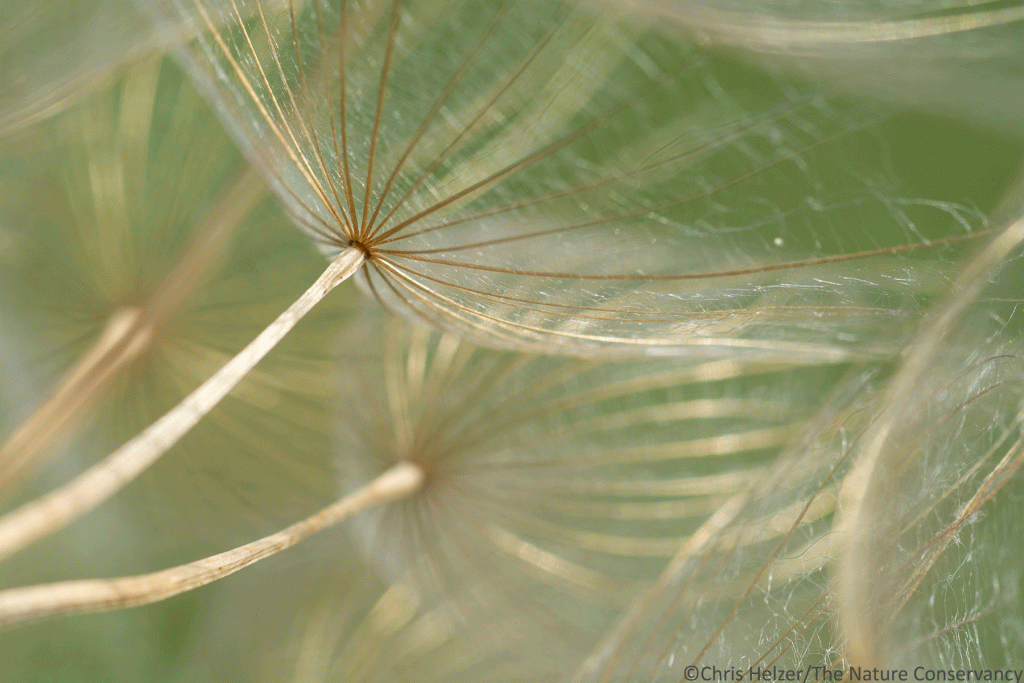
All of the above plant species have contributed positively toward the prairie community. There are, of course, some species that are less welcome. I’m not a fan of the sweet clover (Melilotus sp) that can be abundant on the flatter portions of the site, and am glad that cattle seem to preferentially munch on it, helping to at least keep it shorter and less profuse than it could otherwise be. Smooth brome (Bromus inermis) and Kentucky bluegrass (Poa pratensis) are ubiquitous invaders, but, again, cattle grazing has helped keep them from becoming dominant enough to suppress the increasing abundance and diversity of other species. Eastern red cedar and honey locust are constantly popping up around the prairie, traveling in from nearby woodlots and riparian areas. The cedars are pretty easy to stay on top of, but the locusts take more work, requiring herbicide treatment of the stumps after cutting them.
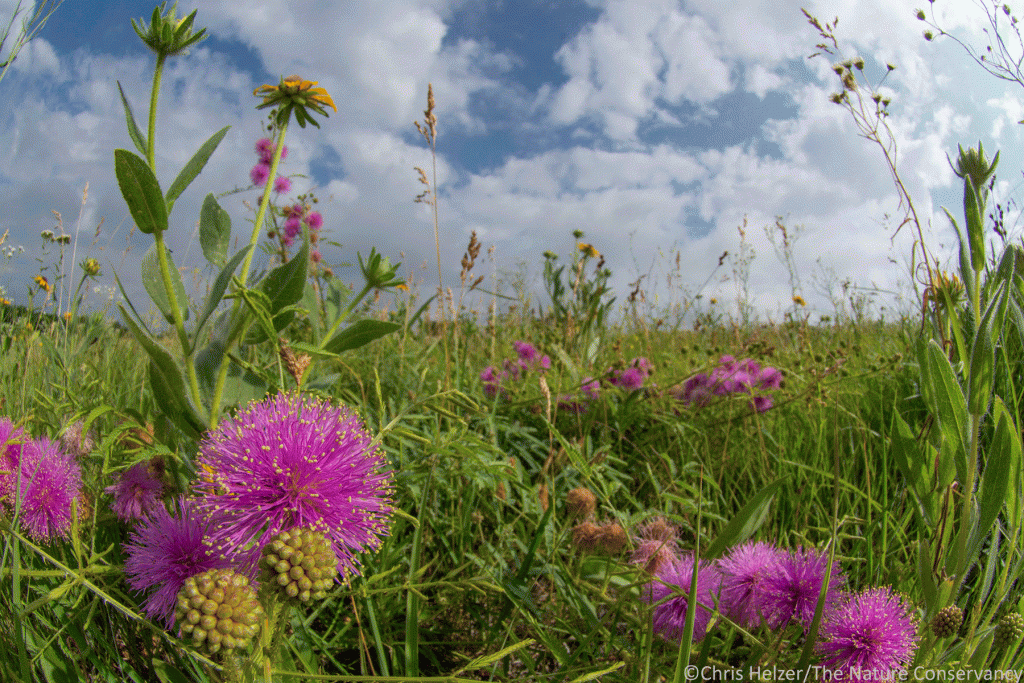

It’s a lot harder to catalog and track the influx of animals. Birds are the easiest of those. Some, like western meadowlarks, grasshopper sparrows, and dickcissels are to be expected, given the size and management of our prairie. We also provide good cover for ring-necked pheasants and northern bobwhite. I’m even more pleased about the consistency with which we see upland sandpipers raising their families on our land since they are trickier to provide for. I even spotted a greater prairie chicken in June a couple years ago, giving me hope that we might have had a nest as well, though our prairie is much too small to regularly attract that species.
I also enjoy seeing evidence of badgers, coyotes, snakes, frogs, and many other small and large animals around the site. Prior to the conversion of the crop land to grass, I doubt most of those species were around much. It’s hard to know how much our efforts to diversify the prairie since then have affected those animals, but I assume there have been some positives.
In terms of invertebrates, I’m constantly amazed by the diversity of pollinators I see on our 100 acre island in the middle of a sea of crops. We harbor the appropriate host plants for monarchs and regal fritillaries, along with other insects, but it’s still gratifying to see those species actually appear each year. I’ve focused hard on making sure our management provides consistent and abundant blooms for pollinators across each season, and I hope that’s helping to maintain those populations. I see plenty of other invertebrates too, but, for the most part, I don’t know what they need to survive or how their populations are doing. I’m just grateful they’re around and part of the community we’re building.

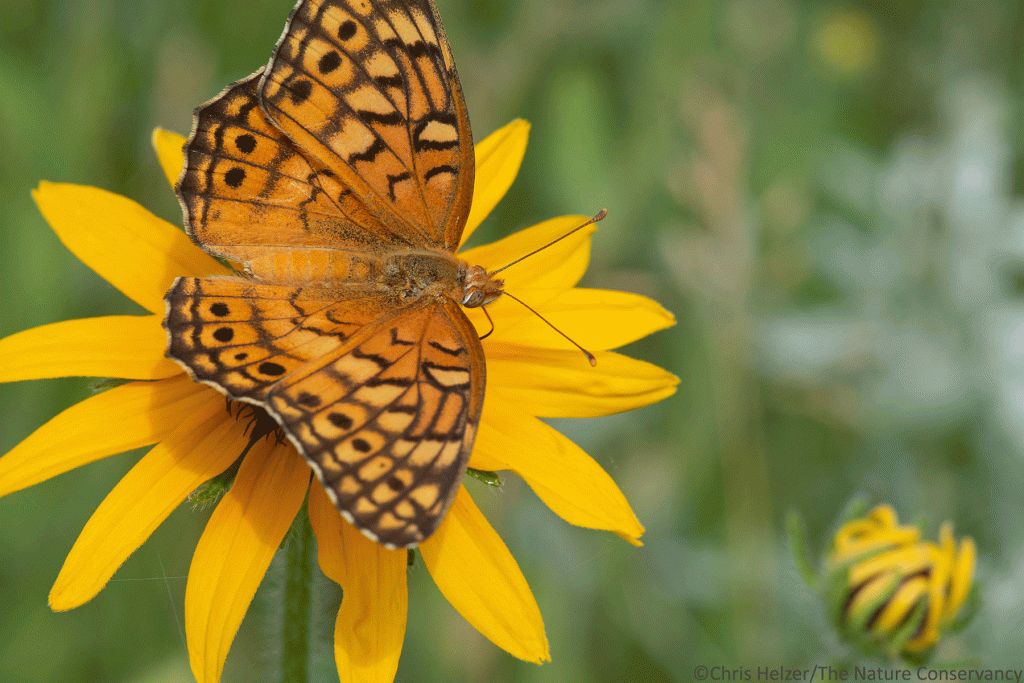

That community, I think, is the main source of the pride and gratification I feel as I walk around our prairie. Because most of what I’m walking across was at one time crop land, and then was planted only to a mixture of grasses, any evidence of increasing diversity makes me happy. There’s a big difference between a grass planting and a prairie. I can’t tell you exactly how to distinguish between them, but species diversity and the complexity of interactions that come with that diversity are critical components. Although I’m biased, I’m very comfortable saying that we now own 100 acres of prairie, rather than about 80 acres of planted grasses surrounding 20 acres of tiny prairie remnants.
Don’t get me wrong, our prairie still has plenty of room for improvement. Plant diversity is still not what I’d like to see across most of the site. We’ll continue overseeding those areas to speed up colonization. That work should help us better sustain populations of the pollinators and other invertebrates that form the foundation for much of the essential functioning of a prairie. Eventually, I hope to take the last 49 acres of cropland that still remains on the high flat portions of our quarter section and convert it to prairie as well. The finances and logistics of that still need to be worked out, but I’m committed to doing that before I hand over the land deed to my kids someday.
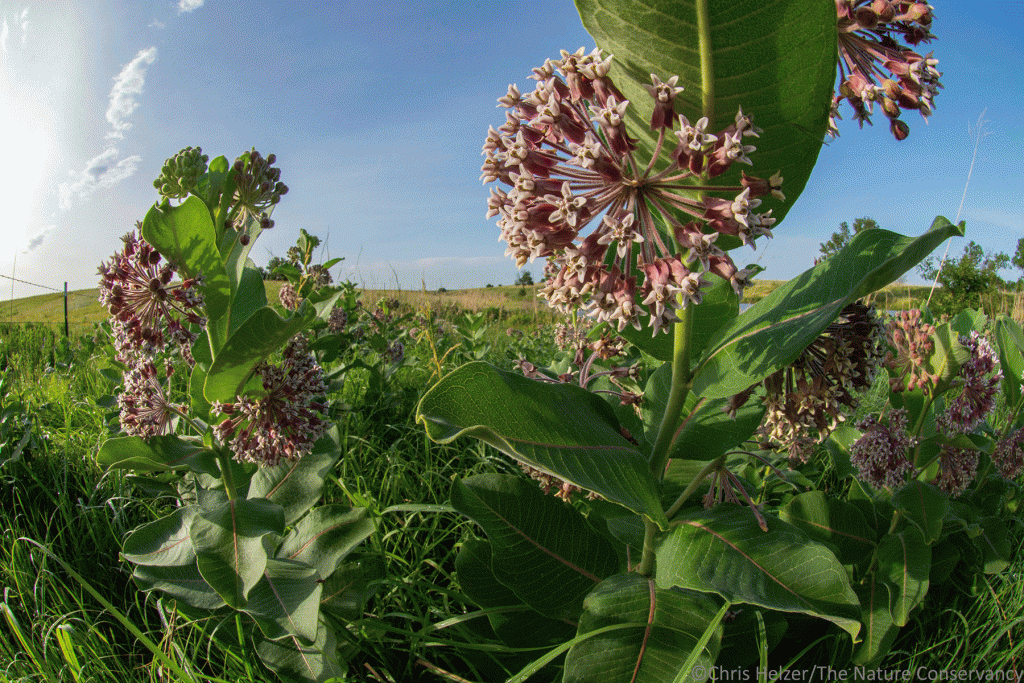
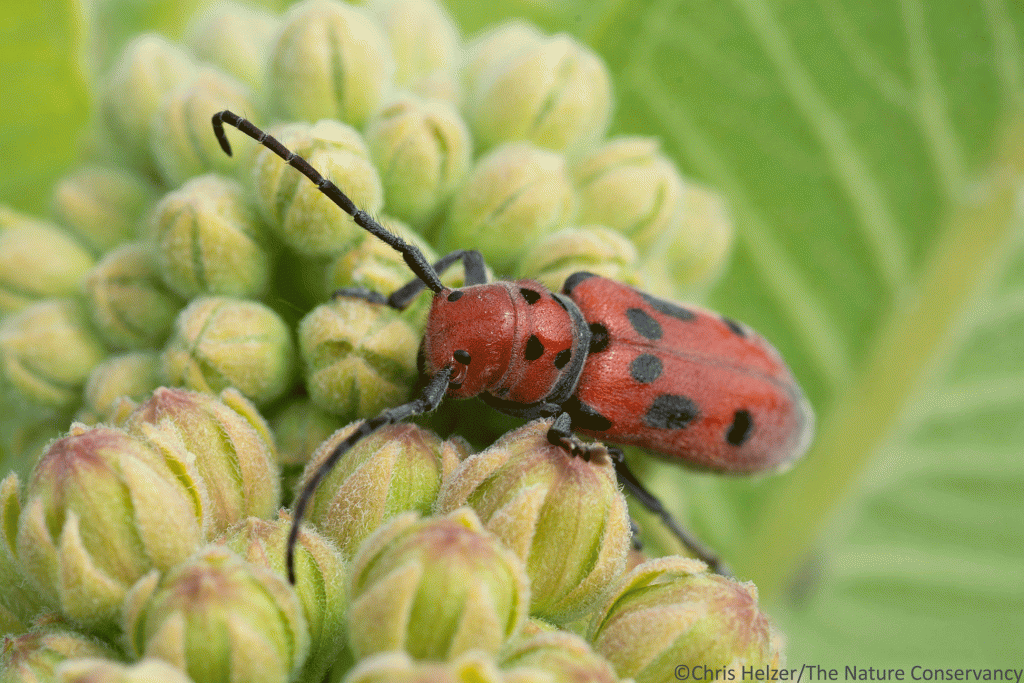
I won’t bore you with all the other issues we still need to address. The point of today’s post is to try to convey the emotions I feel as I celebrate the prairie community our family has helped to create. Those of you who have spent many years working on a piece of land will know the kinds of emotions I’m talking about. I wish I could better explain them to the rest of you.
Here’s my best attempt to summarize: I’m incredibly proud of the diverse plant and animal community that has formed – and continues to form – on our small parcel of land. Walking through the prairie now, surrounding by color, movement, and noise, fills me with contentment and happiness. At the same time, I feel a deep responsibility for all those species and populations that we’ve created habitat for. Because every management strategy helps some species and hurts others, it’s up to us to create shifting management regimes that sustain each of those species through time. That responsibility means my pride, contentment and happiness are tinged with a little anxiety as I survey the results of our most recent management decisions. Perhaps most of all, I feel exceedingly fortunate to have the opportunity to experience all these emotions and to contribute in a small way toward the future of prairies and the species that rely upon them.


What a fine thing – this post, and these 100 acres you have been restoring, and all the living things now present there! Thank you for sharing this tale – of the joys and hopes you have for this place you have been caring for. Inspiring!
Reading this I could feel your delight and excitement, tinged wit just a touch of anxiety, and I could easily relate these to my own.
I do have question, though. What about sedges?
An excellent question, of course. Sedge diversity is pretty low. The remnants have three Carex species. C. heliophila, C. gravida, and C. brevior. The latter two have moved into the restored portions (on their own and through overseeding) but C. heliophila has stayed put – butnia a handy way to delineate the old remnants. We’ve had some success transplanting C. heliophila along the Platte butni haven’t yet tried it at our family prairie.
Wonderful, beautiful, and moving post, Chris. And always instructive for us in our trials with our own minuscule urban prairie project.
Best, always.
So, I am no expert, but at conferences and programs I’ve attended in the last few of my prairie years, I have heard that intensive grazing can be detrimental to a prairie. In fact, here in Texas one of our prairies is managed with rotational grazing where only a certain amount of grazing is allowed. Can you explain the difference? I know the climate is different, and that each prairie has its own set of best practices. How do you know what do try? Just curious!
Here in the urban landscape, our chapter of the Native Prairies Association is encouraging restoration on several sites. In those places we are trying to figure out how to help guys that mow and blow become prairie farmers. I am searching for help for a new prairie restoration at a local courthouse. Do you know of any publication or help a city prairie could get?
Hi Jo Ann, Thank you for the question and for asking it in such a polite way.
Intensive grazing is certainly not something that is universally accepted. Interestingly, that’s true in both ranching circles and prairie management circles. Accordingly, I wouldn’t recommend it universally, either. However, there are a few reasons we’ve used it here in Nebraska (while carefully evaluating results).
Wildlife habitat. Rotational grazing and other conservative grazing strategies tend to be aimed at protecting grass health. As a result, ranchers using those techniques tend not to graze grasses too short because it impacts the vigor of the plants and allows “weeds” to encroach (there are also soil erosion and other potential impacts). One problem with that is that the range of available wildlife habitat structure in those areas tends to be pretty limited. There’s a lot of grass in the medium height/density range but very little in the very short or very tall/dense range. That limits wildlife diversity because many species can’t find the habitat they need. Intensive grazing can create short habitat – and long-term (multiple months or more) intensive grazing can help maintain that short structure for a good part of a growing season – long enough for wildlife to breed and raise young in it. That long-term grazing also has the impacts on the plant community that some ranchers fear – it weakens grasses and allows opportunistic plants a chance to come in. The habitat structure created by that (short sparse grass with lots of forbs) is terrific for many other wildlife – brood-rearing habitat for grouse, quail, etc., but also nice for many herps and invertebrates.
From a plant diversity standpoint, some prairie seem to maintain strong plant diversity with only fire and/or haying. Others (especially western tallgrass and mixed-grass prairies) often become grass dominated in those situations. A shifting mosaic approach (patch-burn grazing, open gate rotation, etc.) can help reduce grass dominance with long-term intensive grazing and then the long-term rest periods provides ample opportunity for other plants (mostly forbs) to acquire and defend space around and between those weakened grasses.
In places where plant diversity seems to be maintained well without grazing, it’s important to think about grazing in terms of whether or not you could increase biodiversity by increasing heterogeneity of habitat without detrimental impacts on the plant community. If so, grazing can be additive. If not, grazing can be damaging. The answer to that question varies from place to place and is interpreted very differently from person to person, depending upon how they define plant community quality.
In places where plant diversity declines without grazing, the question becomes how to graze in a way that creates good habitat heterogeneity and still maintains high plant diversity. Because rotational grazing tends to sustain grass vigor, that’s often detrimental to plant diversity. Periodic intensive grazing (with comparable rest periods) can be better for plant diversity. The key then is to avoid negative impacts to soil and other aspects of the prairie community.
We’re still experimenting with grazing approaches, but I feel pretty confident that the data we’ve collected on the Nebraska sites I manage/advise shows that our grazing is providing great habitat diversity and is as good or better than other approaches for plant diversity too. I have plant community data for more than 20 years on some sites, showing that we’re not losing plant species (though relative abundance is certainly different between grazed and ungrazed) and, in some cases, are increasing it – compared to other management systems. Whether that holds true in all other situations is more difficult – every site is different and small prairies, especially, don’t always make sense to be grazed.
If you’re interested, you could read more about the shifting mosaic approach here: https://prairieecologist.com/2016/03/08/prairie-word-of-the-day-shifting-mosaic-of-habitat/
In terms of urban prairies, there are different approaches and resources you might look at. You could check out my prairie management book, of course, which might be useful in terms of understanding overall prairie ecology and management – which can be translated down into smaller sites. I’ve also written a little on managing small prairies and prairie gardens here on my blog. https://prairieecologist.com/2013/10/28/the-conservation-value-of-backyard-prairies/ and https://prairieecologist.com/2012/03/05/how-should-we-manage-small-prairies/
Apart from that, some of the decisions you should be thinking about are whether it’s going to be a prairie or a garden. Will it be horticulturally designed with spacing between plants and a neat orderly look or will it be a garden that is managed as a plant community. Both can be great, but the aesthetics and management differ between them. I’d encourage you to speak to locals who have done gardens the way you want them to look and take advantage of the lessons they’ve learned in landscapes similar to yours. Trying to learn from project further away might not be as helpful
Good luck!
In our crazy world, these photos are worth a pause and look-at and relax. Thanks for posting :)
This is my idea of thrilling reading! Thank you for your continuing hard work and enthusiasm.
I recently passed on a couple of your posts to someone in Minnesota who also is involved in the restoration of family prairie. Having resources like your information — and your reflections– to draw on is such a gift, and this post was such an inspiration.
I’ve been helping restore a prairie that has been degraded by intensive grazing. The site probably did not get rest as is included in your management regime. The highest quality parts of this prairie have thin soil over dolomite which appears to favor cool season species. Moisture is only consistently available in thin soil areas in spring.
We are removing red clover, wild parsnip, yellow sweet clover, white sweet clover, and many invasive woody species. However, we are not doing anything about smooth brome or bluegrass. To reduce smooth brome and bluegrass, experts recommend a spring burn.
However, this would set back all the native cool season grasses, sedges, and other wildflowers just as much as the smooth brome and bluegrass. I think spring burning would even favor smooth brome and bluegrass because the native species feed insects, soil fungi, and a whole host of other organisms with which the non-native species have not co-evolved. I am equally leery of herbicide use since I think it would harm the native plants more than non-native species for the same reason. The only action I think would work is to scythe or weed whack patches dominated by smooth brome or bluegrass.
Maybe now that the grazing has stopped, the smooth brome and bluegrass will diminish slowly without intervention. In that case our efforts would be better directed at other priorities. It is difficult to know what to do. The only way to know is to monitor the situation and act based on what is observed. I think this is beyond my scope since my place in the restoration hierarchy is to dig out or cut weeds.
In the meantime, I need to decide if I should try to do some cutting of smooth brome and bluegrass to see if it helps. Does anyone have suggestions? I’d prefer to not waste my time on a problem that might solve itself, but I also don’t want to do nothing and let the problem get worse if that is the direction in which the ecosystem is heading.
I wanted to add that I am not trying to be contradictory regarding the use of herbicides. I have experiences where hand wicking was performed, and adjacent plants were severely damaged. The invasive species later came back unfazed. Sometimes invasive species return unfazed even after repeated applications. In contrast, removing the entire root of invasive species has proven effective. No new seedlings were observed after a few years of follow-up. The area where invasive species were removed by the root are still free of invasive species. Whereas areas that are sprayed for them annually still have an ongoing problem. I have also seen where spraying shows little effect the following year on a targeted invasive species. In contrast, a native who was misidentified by the applicator and sprayed has not returned.
James,
I am very slow to getting to these posts, so I realize I’m late to reply. There has been a great effort by USFWS looking at Kentucky bluegrass and smooth brome invasion. What I can tell you in short, do nothing and you will have more of both instead of less. Burning for KBG and heavy grazing for SB appear to be the best options for natives to gain back some ground. This has been the results of Native Prairie Adaptive Management study that has over 10 years of data collection from the PPR of Montana to Minnesota. Soil health is definitely something that is on the horizon that needs more research. Invasive plants seem to be able to change the soil make up (bacteria and fungus among other things), the question now becomes, what can we do to encourage the soil structure/ways of our natives once invasives have changed it….that I don’t know.
I’m including a link for a publication that NDSU put out. While you are not trying to start from scratch, it might provide some direction.
https://www.ag.ndsu.edu/publications/environment-natural-resources/prairie-reconstruction-guidebook-for-north-dakota
“What I can tell you in short, do nothing and you will have more of both instead of less.”
Yes, unfortunately this is what I had thought. I should have been more specific in my original comment that the blue grass which is a problem on these dolomite hill prairies is Poa compressa. The highest quality areas up on the top of the hills are completely interspersed with this species. The smooth brome is patchier in the driest high-quality areas, is thicker in more dry-mesic areas, and is dominant in areas with no prairie species. These patches of mostly just smooth brome, wild parsnip, and a few other invasive species have been attributed to grazing. However, since other areas at the base of the hills still have conservative plants, the areas dominated by smooth brome are more likely the result of other causes like prior herbicide use, animal confinement, or vehicles.
I could probably reduce the smooth brome in the highest quality dry areas by selectively cutting it in spring to give the natives the advantage. However, the Poa compressa would be much harder to control. The area is regularly burned, so that is already being done. The only thing I can think to do is pull the Poa compressa up, which is only possible because the tops of these dry dolomitic hills are a relatively small part of the overall landscape. Still, pulling up a short invasive grass over several acres would be a very difficult task. What might be even more difficult is to get approval to work on these species when volunteers and staff are already overwhelmed by other priorities that they consider to be more urgent.
Thank you for sharing the report. I will look through it and consider what finding would apply to the areas I am working which are in Illinois.
Dear Chris,
These photos of your family’s restored gem are really beautiful.
Are you sure you want to welcome goat’s beard to your beautiful grazed prairie? We southwestern Wisconsin prairie enthusiasts try to pull all of that before it goes to seed.
Stephanie Eastwood Woodford, WI
On Mon, Jun 29, 2020 at 12:08 PM The Prairie Ecologist wrote:
> Chris Helzer posted: ” Over the last couple weeks, I’ve been trying to > figure out how to describe the joy, contentment, and pride I feel when I > walk around our family prairie. The old saying about photographs being > worth 1000 words applies in a way, I guess, so I’m including ” >
Hi Stephanie,
I certainly won’t fault anyone for removing goatsbeard from their prairies, but over the roughly 30 years I’ve been exploring and studying prairies in this area, I’ve never seen it act in a way detrimental to plant diversity or the plant community. There are numerous invasive plants we worry about, but goatsbeard isn’t on the list (again, here). It ebbs and flows with disturbance, but doesn’t increase steadily in abundance over time. The only exception was when I moved one into a garden along my house. I won’t do that again, but then there are a number of native plants I’d put in that same category of rapid spreaders in a landscaped environment. In a wild Nebraska prairie setting, it seems to be a species that settles in and then plays nicely. Best of luck with your prairie management work – thank you for all your efforts!
This gives me encouragement and hope for my own 60 acre project! Thank you so much for this post!
On week 1 of my personal “Square Meter” project inspired by your newest book!
So cool to hear! Good luck on your square meter adventure!
Hi Chris – I relate to your feelings of pride in what you have been able to restore on your property. What this provokes then is the question of how you hope all this work, in essence your legacy in the land, won’t be lost to conversion in the future, but rather continue to be improved upon. Think what lessons would be lost if the next landowner thought the soil would better used (for them) for growing corn and soybeans.
Is it reasonable or fair to place this kind of burden on heirs? Would they feel trapped by obligation? What if their jobs take them away from Nebraska? Who would manage it then? Countless farmers and small business owners have faced similar questions about how to have the work they started be transferred to heirs who can build on their legacy, only to realize it doesn’t always work out that way.
Your land is beginning to show an identity of its own, one that is now inextricably linked to yours. Can its identity remain intact if it is sold?
I admit these may be uncomfortable questions, but ones I hope you might consider addressing in future posts because others might be struggling with them too. I would not have asked them if I haven’t wrestled with them myself.
Nice work! I remember what a shock it was when I first heard Allan Savory talking about some of these management ideas.
Chas, Allan Savory and I see the world very very differently. For example, I think fire is a good and helpful process for grasslands. I’m also using season-long grazing and long rests, rather than the more short-term targeted grazing Savory promotes. If you’re interested, I wrote about some of my concerns about Savory’s approaches several years ago. https://prairieecologist.com/2015/02/09/concerns-about-earth-a-new-wilds-messages-about-grassland-conservation/
Pingback: Weeds and Feed: Learning from a Prairie Hill | Lone Tree Farm on Kanaranzi Creek